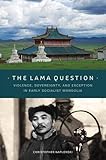The Lama Question : Violence, Sovereignty, and Exception in Early Socialist Mongolia / Christopher Kaplonski.
Material type: TextPublisher: Honolulu : University of Hawaii Press, [2014]Copyright date: ©2014Description: 1 online resource (280 p.) : 5 b&w images, 1 mapContent type:
TextPublisher: Honolulu : University of Hawaii Press, [2014]Copyright date: ©2014Description: 1 online resource (280 p.) : 5 b&w images, 1 mapContent type: - 9780824838560
- 9780824838577
- 303.609517 23
- online - DeGruyter
- Issued also in print.
| Item type | Current library | Call number | URL | Status | Notes | Barcode | |
|---|---|---|---|---|---|---|---|
 eBook
eBook
|
Biblioteca "Angelicum" Pont. Univ. S.Tommaso d'Aquino Nuvola online | online - DeGruyter (Browse shelf(Opens below)) | Online access | Not for loan (Accesso limitato) | Accesso per gli utenti autorizzati / Access for authorized users | (dgr)9780824838577 |
Frontmatter -- Contents -- Acknowledgments -- Note on Transliteration -- Dramatis Personae and Terms -- Map of Mongolian Provinces -- Introduction: There Are No Counterrevolutionaries Here -- 1. Technologies of Exception, Governmentality, and the Contingent State -- 2. The Geopolitics of Exception -- Part I. The First Technology of Exception: The Construction of the New -- 3. Women, Literacy, and Other Dangerous Things -- 4. Counting (on) the Living Gods -- 5. Samdan, the Special Commission, and the Rule of Law -- 6. Rebellions, War, and Aftermaths -- Part II. The Second Technology of Exception: Ineffective Persuasions and Accommodation -- 7. Surveillance and Control: The Religious Administration and the Government Representatives -- 8. A Tale of Two Lamas: Gonchigjantsan and Agvaanjamyan -- Part III. The Third Technology of Exception: The Turn to Violence, Resignation, and Defeat -- 9. The Yonzon Hamba and the Center Counterrevolutionary Group -- 10. Closed and Destroyed Monasteries: The Aftermath -- Conclusion: Violence and the Contingent State -- Notes -- Reference List -- Index
restricted access online access with authorization star
http://purl.org/coar/access_right/c_16ec
Before becoming the second socialist country in the world (after the Soviet Union) in 1921, Mongolia had been a Buddhist feudal theocracy. Combatting the influence of the dominant Buddhist establishment to win the hearts and minds of the Mongolian people was one of the most important challenges faced by the new socialist government. It would take almost a decade and a half to resolve the "lama question," and it would be answered with brutality, destruction, and mass killings. Chris Kaplonski examines this critical, violent time in the development of Mongolia as a nation-state and its ongoing struggle for independence and recognition in the twentieth century.Unlike most studies that explore violence as the primary means by which states deal with their opponents, The Lama Question argues that the decision to resort to violence in Mongolia was not a quick one; neither was it a long-term strategy nor an out-of control escalation of orders but the outcome of a complex series of events and attempts by the government to be viewed as legitimate by the population. Kaplonski draws on a decade of research and archival resources to investigate the problematic relationships between religion and politics and geopolitics and biopolitics in early socialist Mongolia, as well as the multitude of state actions that preceded state brutality. By examining the incidents and transformations that resulted in violence and by viewing violence as a process rather than an event, his work not only challenges existing theories of political violence, but also offers another approach to the anthropology of the state. In particular, it presents an alternative model to philosopher Georgio Agamben's theory of sovereignty and the state of exception.The Lama Question will be of interest to scholars and students of violence, the state, biopolitics, Buddhism, and socialism, as well as to those interested in the history of Mongolia and Asia in general.
Issued also in print.
Mode of access: Internet via World Wide Web.
In English.
Description based on online resource; title from PDF title page (publisher's Web site, viewed 02. Mrz 2022)


